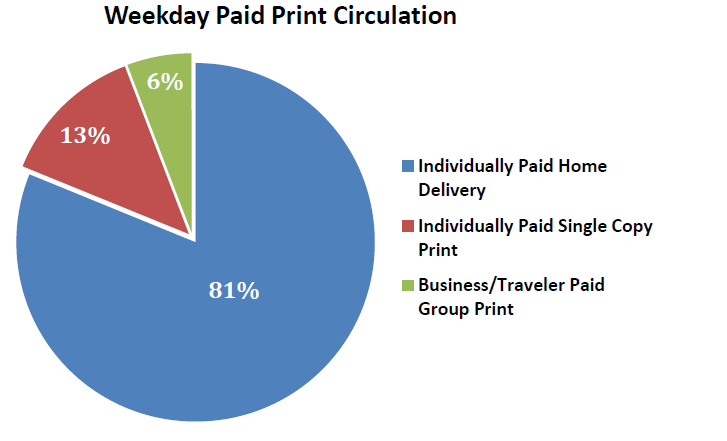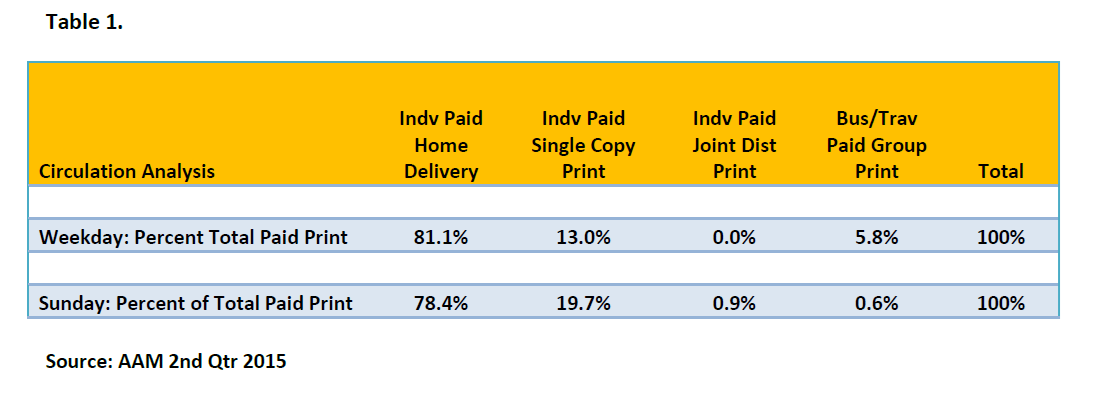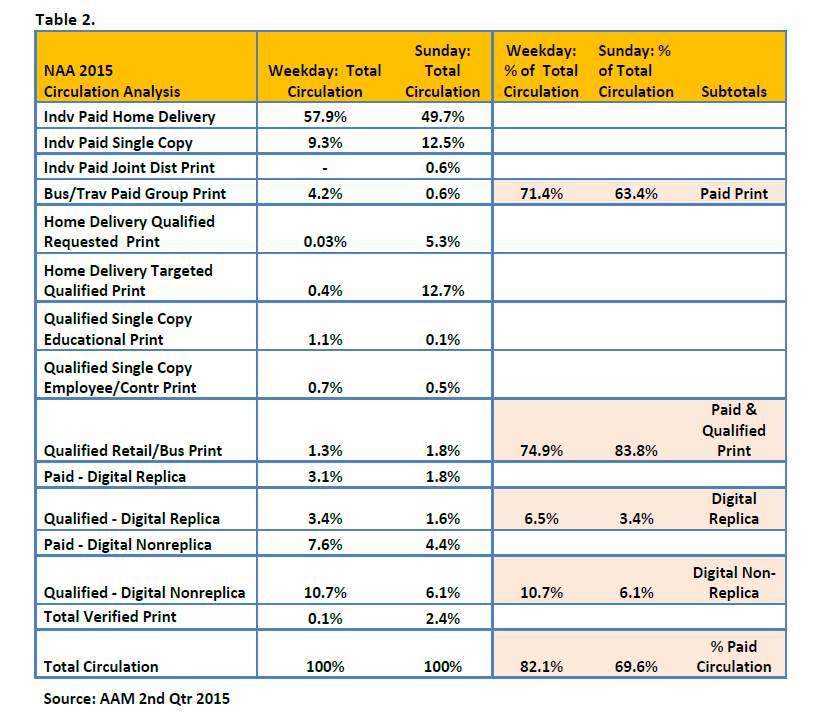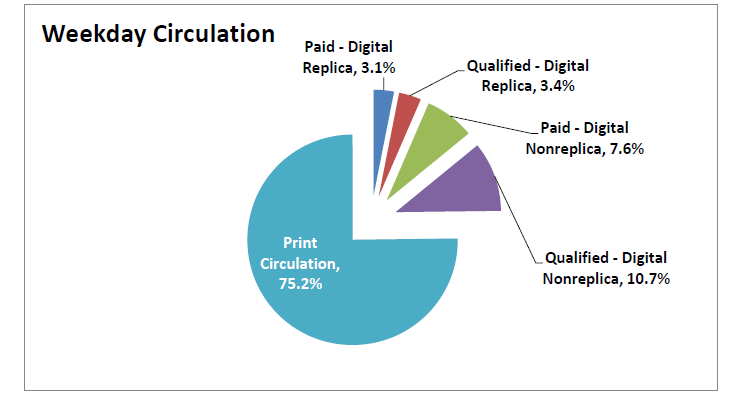AAM Total Circulation is Increasingly Divided among Many Components, including Digital
Download a pdf of the full report here.
The traditional paid home delivery subscription continues to be the largest category in the Alliance of Audited Media’s (AAM) “total paid print circulation” metric. Despite the many changes in marketing newspaper content, the home delivery subscription continues to mark consumer preferences and has become an increasingly important source of newspaper revenue.

The definition of “paid print circulation” was narrowed after 2010 when the category of “qualified circulation” was added to the reporting options. This change eliminated categorical trending to prior years. Nuances aside, eight of ten copies of paid print circulation are now home delivered to subscribers. Although the majority of newspaper print subscribers are multi-platform readers, it is clear that Sunday and weekday home delivery remains the most popular sales channel for marketing print newspapers. (See Table 1)
Eight of ten copies of paid print circulation are now home delivered to subscribers.

Average weekday circulation has become a less relevant metric today because newspapers sell fewer seven-day subscriptions and therefore it understates the reach of key days that include most of the print advertising, which are the most profitable days of the week. For most newspapers, their print reach is much higher than the weekday average. And this is true of the industry as a whole. But it is still meaningful for measuring the relative importance of each of the sales channels and circulation classifications.
The value of the AAM “Total Circulation” metric is in the inclusion of the individual components.
During the last five years, AAM has continually increased the transparency of circulation reporting for newspapers. At the same time, the organization has maintained the integrity of the process newspapers must follow to classify copies, print or digital, to be included in a designated circulation category. The metric labeled “total circulation” provides newspapers a better opportunity to report all of its products designed to build audience and readership. It also provides a menu of choices for advertisers.
The “total circulation metric” is not intended to be a meaningful number in itself. It is the dozen or so categories that comprise “total circulation” that provide the advertiser improved insight into what they are buying, and how it will deliver an audience.
Wisely, less attention is given to comparing different newspapers’ “total circulation” or the industry’s “total circulation.” In itself it is not a metric of success. In fact, many newspapers chose not to report copies that could be included in the total. Attention is instead directed to the various components that appeal to advertisers and comprise what is defined as total circulation and its subtotals.
Paid print circulation remains dominant. This has been critical to newspapers because the average circulation revenue per print subscriber has increased by more than 50 percent in the last five years, newsstand prices have increased at a similar rate, and advertising insert revenue is directly tied to print circulation. So while print circulation is less important in gauging a newspaper’s total audience, it does represent an important slice of revenue.
It is the dozen or so categories that comprise “total circulation” that provide the advertiser improved insight into what they are buying, and how it will deliver an audience.
The industry averages are just that – averages.
Within the newspaper industry certain similar strategies have emerged among individual newspapers. Sweeping changes such as charging readers more for home delivery subscriptions and single copy editions, development of new Sunday targeted free editions, and encouraging print subscribers to become cross platform users are strategies common to most newspapers. But in other areas, newspapers take disparate paths and, increasingly, circulation reporting is an example.

On weekdays, paid print is 71.4 percent of total circulation. On Sundays, 63.4 percent is paid print. (See Table 2) The percentage is lower on Sundays because newspapers have been successful in marketing free Sunday products that are either requested by subscribers (5.3 percent of paid print circulation) or targeted to specific households (12.7 percent).
Single copy continues to be an important component, particularly on Sundays. Sunday single copy sales are 19.7 percent of paid print circulation and at least 12.5 percent of total circulation. Qualified single copy in total, a growing category for newspapers that appreciate the simplicity of reporting, contributes another 2.5 percent to the Sunday circulation total. As newspapers shift from newsracks and add a multiplicity of small, over-the-counter locations (e.g. fast food, breakfast hot spots and smaller retailers), in some cases, they do not warrant the procedures and controls necessary to qualify as individually paid single copy sales.
Reporting digital circulation remains a choice rather than an obligation.
Digital circulation is 24.8 percent of reported total average weekday circulation and 13.9 percent of total Sunday circulation. Newspapers are now reporting more digital non-replica circulation than digital replica circulation.

And, many newspapers do not report any qualified digital circulation. For example, the digital audience engaged with newspaper content reached a new peak in August 2015, totaling 179.3 million adult unique visitors. The count is a 10% increase in adult unique visitors measured by comScore since August 2014, and is double the growth rate for the Internet overall (5%, NAA, October 2015). The reported digital circulation data does not reflect that growth.
Digital replica circulation, however, is more relevant because digital replica editions include print advertising, and the digital replica circulation needs to be added to the print circulation to measure the implied reach of an ROP advertisement.
Circulation size does differentiate newspaper reporting.
Newspapers with less than 50,000 Sunday circulation, the majority of AAM newspapers, do look different than the industry average, as do the largest newspapers. For example, newspapers with less than 50K circulation are less likely to report digital copies. AAM daily newspapers overall reported 13.9 percent of total Sunday circulation as digital. For smaller newspapers, the average is 5.9 percent digital. This is due to a number of factors and does not necessarily indicate these newspapers are unsuccessful in drawing readers into their digital offerings. In some cases these newspapers are simply paying less attention to the total circulation metrics. These newspapers may be avoiding the rigors of reporting qualified digital circulation that cannot be monetized utilizing traditional circulation metrics. The largest difference is in reporting non-replica digital circulation. Newspapers with less than 50K circulation reported 2.1 percent of total circulation as digital non-replica and the AAM average is 10.5 percent for the same period. The digital replica breakdown is identical, with 3.4 percent of total Sunday circulation.
Paid home delivery comprises 49.7 percent of AAM total circulation, but it is 57.9 percent of total circulation for newspapers reporting less than 50K Sunday circulation. This segment of smaller newspapers reported 15.3 percent of total circulation as paid single copy sales compared to the industry average of 12.5 percent. (Table 2)
Circulation and readership provide a comprehensive picture of newspaper marketing effectiveness.
AAM circulation reporting still provides a glimpse into how newspapers are going to market to build readership and attract advertisers. Although audited circulation reporting continues to be essential for a newspaper marketing its ability to deliver for insert advertisers, readership data remains a more insightful metric for measuring total audience and third-party providers such as comScore are the credible sources for marketing a newspaper’s digital reach.
The Alliance of Audited Media responds to this challenge effectively by encouraging newspapers to include all of this data in the newspaper’s Consolidated Media Report published by AAM. Increasingly, reporting circulation data is only one reason for a newspaper to submit its data to AAM and to utilize AAM as a portal to reach perspective advertisers.
As reader behaviors change, the composition of the newspaper industry’s total circulation will also continue to evolve. Newspapers’ responses to these changes will reflect the most cost-effective means of building their total audience and offering it in relevant segments to their advertising customers.
For a pdf of the full report, click here.

Former Vice President, Audience Development at News Media Alliance.

